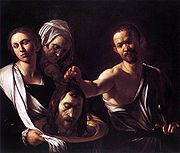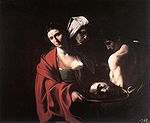.gif)
The Beheading of Saint John the Baptist (Caravaggio)
Encyclopedia
The Beheading of Saint John the Baptist is an oil painting
by the Italian artist Caravaggio
. According to Andrea Pomella in Caravaggio: An Artist through Images (2005), the work is widely considered to be Caravaggio's masterpiece as well as "one of the most important works in Western painting."
while nearby Salome
stands with a golden platter to receive his head. Another woman, who has been identified as Herodias
or simply a bystander who realizes that the execution is wrong, stands by in shock while a jailer issues instructions and the executioner draws his dagger to finish the beheading. The scene, popular with Italian artists in general and with Caravaggio himself, is not directly inspired by the Bible
, but rather by the tale as related in Golden Legend
.
It is the only work by Caravaggio to bear the artist's signature, which he has placed in red blood spilling from the Baptist's cut throat. There is considerable empty space in the image, but because the canvas is quite large the figures are approximately life-sized.
According to John Varriano in Caravaggio: the Art of Realism (2006), Caravaggio drew the background for his picture from the depiction of a prison in the Knights of Malta's penal code. Characteristically of his later paintings, the number of props and the detail in the props used is minimal.
 Completed in 1608 in Malta
Completed in 1608 in Malta
, the painting had been commissioned by the Knights of Malta
as an altarpiece
; it was the largest altarpiece which Caravaggio would ever paint. It still hangs in St. John's Co-Cathedral, for which it was commissioned and where Caravaggio himself was inducted and briefly served as a knight. Caravaggio's service to the Order was brief and troubled, however, as he was soon a fugitive
from justice, having escaped while imprisoned for an unrecorded crime. When Caravaggio was defrocked in absentia as a "putrid and fetid limb" by the Order about six months after his induction, the ceremony took place in the Oratory, before this very painting.
 Caravaggio did several pieces depicting the moments after the event depicted here. One of these is on display in London's National Gallery
Caravaggio did several pieces depicting the moments after the event depicted here. One of these is on display in London's National Gallery
; the other, in the Royal Palace of Madrid
. It is believed that one of these may be the image that Caravaggio was said to have sent in an effort to appease Alof de Wignacourt
, Grand Master
of the Knights who expelled Caravaggio, but this is not certainly known.
The Beheading of Saint John the Baptist has been badly damaged, though it did receive some restoration in the 1950s prior to a notable exhibition in Rome
in 1955-56, which brought the work considerable attention. It was during the restoration that Caravaggio's signature in the blood became visible to modern viewers. The signature is a matter of some dispute. Some scholars, including Genevieve Warwick in Caravaggio: Realism, Rebellion, Reception (2006), suggest that the work is signed f. Michelang.o (the f to indicate his brotherhood in the order), but it is popularly claimed that Caravaggio signed "I, Caravaggio, did this" in confession of some crime—perhaps connected to the 1606 death of Ranuccio Tomassoni at Caravaggio's hands, which had caused the painter to flee Rome.
Oil painting
Oil painting is the process of painting with pigments that are bound with a medium of drying oil—especially in early modern Europe, linseed oil. Often an oil such as linseed was boiled with a resin such as pine resin or even frankincense; these were called 'varnishes' and were prized for their body...
by the Italian artist Caravaggio
Caravaggio
Michelangelo Merisi da Caravaggio was an Italian artist active in Rome, Naples, Malta, and Sicily between 1593 and 1610. His paintings, which combine a realistic observation of the human state, both physical and emotional, with a dramatic use of lighting, had a formative influence on the Baroque...
. According to Andrea Pomella in Caravaggio: An Artist through Images (2005), the work is widely considered to be Caravaggio's masterpiece as well as "one of the most important works in Western painting."
Composition
The image depicts the execution of John the BaptistJohn the Baptist
John the Baptist was an itinerant preacher and a major religious figure mentioned in the Canonical gospels. He is described in the Gospel of Luke as a relative of Jesus, who led a movement of baptism at the Jordan River...
while nearby Salome
Salome
Salome , the Daughter of Herodias , is known from the New Testament...
stands with a golden platter to receive his head. Another woman, who has been identified as Herodias
Herodias
Herodias was a Jewish princess of the Herodian Dynasty. Asteroid 546 Herodias is named after her.-Family relationships:*Daughter of Aristobulus IV...
or simply a bystander who realizes that the execution is wrong, stands by in shock while a jailer issues instructions and the executioner draws his dagger to finish the beheading. The scene, popular with Italian artists in general and with Caravaggio himself, is not directly inspired by the Bible
Bible
The Bible refers to any one of the collections of the primary religious texts of Judaism and Christianity. There is no common version of the Bible, as the individual books , their contents and their order vary among denominations...
, but rather by the tale as related in Golden Legend
Golden Legend
The Golden Legend is a collection of hagiographies by Jacobus de Voragine that became a late medieval bestseller. More than a thousand manuscripts of the text have survived, compared to twenty or so of its nearest rivals...
.
It is the only work by Caravaggio to bear the artist's signature, which he has placed in red blood spilling from the Baptist's cut throat. There is considerable empty space in the image, but because the canvas is quite large the figures are approximately life-sized.
According to John Varriano in Caravaggio: the Art of Realism (2006), Caravaggio drew the background for his picture from the depiction of a prison in the Knights of Malta's penal code. Characteristically of his later paintings, the number of props and the detail in the props used is minimal.
History

Malta
Malta , officially known as the Republic of Malta , is a Southern European country consisting of an archipelago situated in the centre of the Mediterranean, south of Sicily, east of Tunisia and north of Libya, with Gibraltar to the west and Alexandria to the east.Malta covers just over in...
, the painting had been commissioned by the Knights of Malta
Knights Hospitaller
The Sovereign Military Hospitaller Order of Saint John of Jerusalem of Rhodes and of Malta , also known as the Sovereign Military Order of Malta , Order of Malta or Knights of Malta, is a Roman Catholic lay religious order, traditionally of military, chivalrous, noble nature. It is the world's...
as an altarpiece
Altarpiece
An altarpiece is a picture or relief representing a religious subject and suspended in a frame behind the altar of a church. The altarpiece is often made up of two or more separate panels created using a technique known as panel painting. It is then called a diptych, triptych or polyptych for two,...
; it was the largest altarpiece which Caravaggio would ever paint. It still hangs in St. John's Co-Cathedral, for which it was commissioned and where Caravaggio himself was inducted and briefly served as a knight. Caravaggio's service to the Order was brief and troubled, however, as he was soon a fugitive
Fugitive
A fugitive is a person who is fleeing from custody, whether it be from private slavery, a government arrest, government or non-government questioning, vigilante violence, or outraged private individuals...
from justice, having escaped while imprisoned for an unrecorded crime. When Caravaggio was defrocked in absentia as a "putrid and fetid limb" by the Order about six months after his induction, the ceremony took place in the Oratory, before this very painting.

National gallery
The National Gallery is an art gallery on Trafalgar Square, London, United Kingdom.National Gallery may also refer to:*Armenia: National Gallery of Armenia, Yerevan*Australia:**National Gallery of Australia, Canberra...
; the other, in the Royal Palace of Madrid
Royal Palace of Madrid
The Palacio Real de Madrid is the official residence of the King of Spain in the city of Madrid, but it is only used for state ceremonies. King Juan Carlos and the Royal Family do not reside in the palace, choosing instead the more modest Palacio de la Zarzuela on the outskirts of Madrid...
. It is believed that one of these may be the image that Caravaggio was said to have sent in an effort to appease Alof de Wignacourt
Alof de Wignacourt
Fra' Alof de Wignacourt was the 54th Grand Master of the Order of Malta, from 1601 to 1622. He was of the langue of France. His reign was notable for the construction of a number of coastal fortifications , and of the aqueduct that brought water from the plateau above Rabat to Valletta...
, Grand Master
Grand Master (order)
Grand Master is the typical title of the supreme head of various orders of knighthood, including various military orders, religious orders and civil orders such as the Ancient Order of Hibernians and the Orange Order...
of the Knights who expelled Caravaggio, but this is not certainly known.
The Beheading of Saint John the Baptist has been badly damaged, though it did receive some restoration in the 1950s prior to a notable exhibition in Rome
Rome
Rome is the capital of Italy and the country's largest and most populated city and comune, with over 2.7 million residents in . The city is located in the central-western portion of the Italian Peninsula, on the Tiber River within the Lazio region of Italy.Rome's history spans two and a half...
in 1955-56, which brought the work considerable attention. It was during the restoration that Caravaggio's signature in the blood became visible to modern viewers. The signature is a matter of some dispute. Some scholars, including Genevieve Warwick in Caravaggio: Realism, Rebellion, Reception (2006), suggest that the work is signed f. Michelang.o (the f to indicate his brotherhood in the order), but it is popularly claimed that Caravaggio signed "I, Caravaggio, did this" in confession of some crime—perhaps connected to the 1606 death of Ranuccio Tomassoni at Caravaggio's hands, which had caused the painter to flee Rome.

